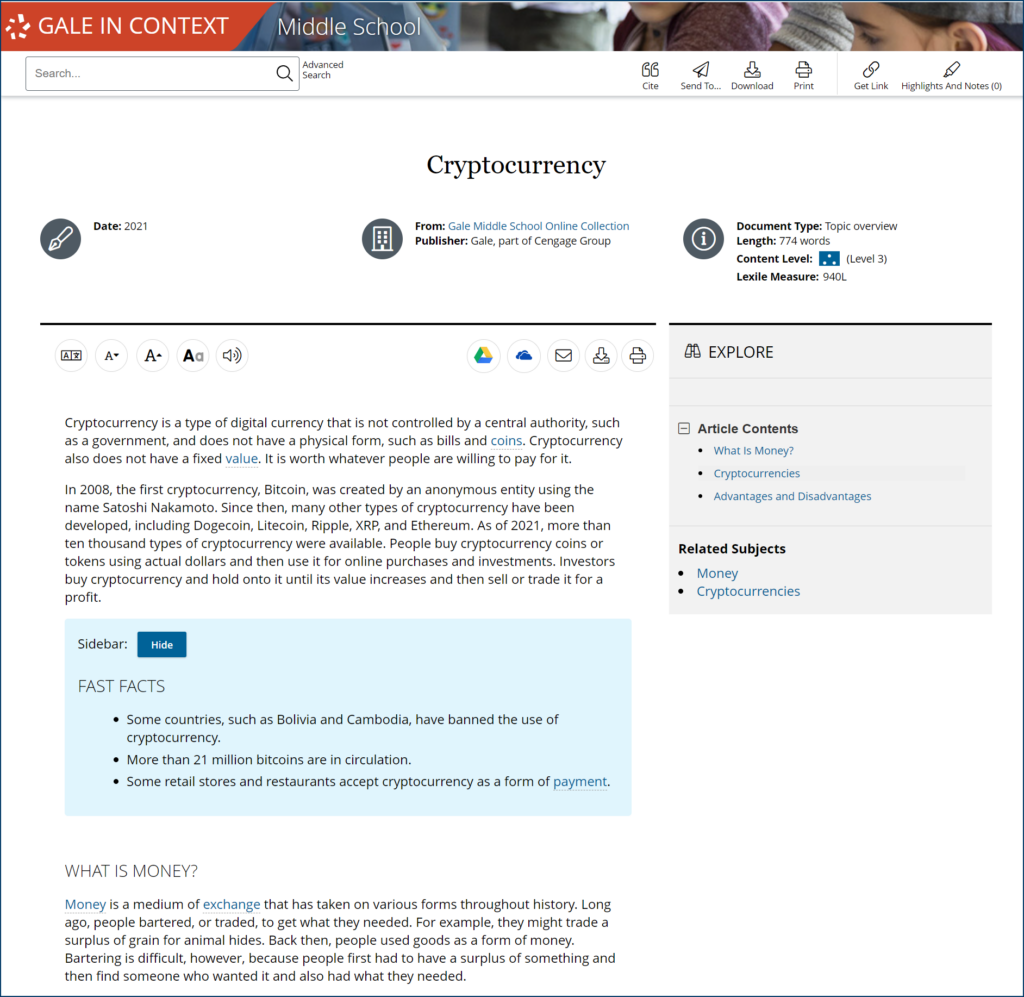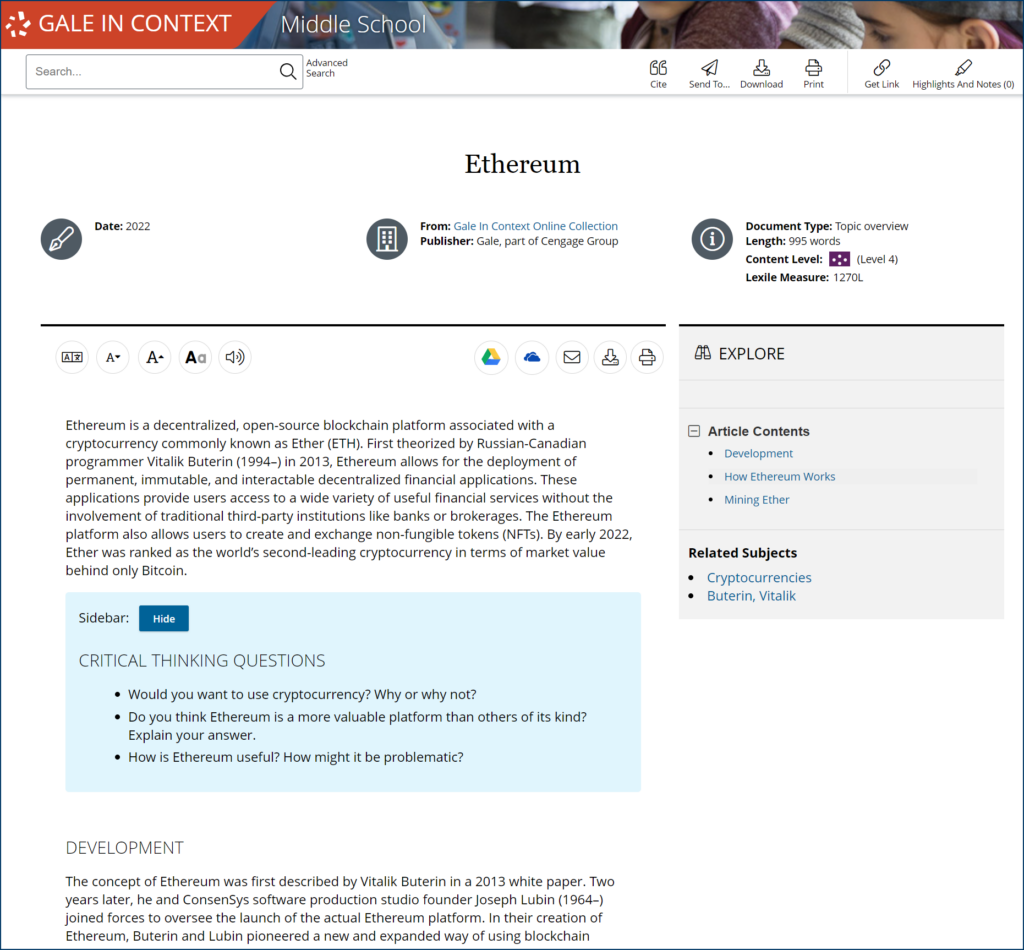| By Gale Staff |
Educators’ focus on teaching students about money once consisted of straightforward lessons about calculating interest rates, creating a savings account, and basic budgeting. Now, with the ever-increasing talk about digital currencies gaining traction across YouTube and TikTok, teaching financial literacy has shifted to include concepts like Bitcoin and blockchain.
While it can be overwhelming for learners and educators alike, the right approach backed by high-quality, vetted resources can spark their curiosity and lead to meaningful discussions about how the future unfolding today might look tomorrow.
The Gale In Context: Middle School database combines information about these nebulous-seeming topics into a go-to resource that helps educators introduce the intricacies of digital currencies at each student’s learning level and preferred format. Gale In Context offers authoritative content that accommodates different learning styles, from books and newspapers to audio clips and video—all in an efficient, easy-to-use platform.
To help educators plan how to incorporate digital currencies into their existing curriculum and demonstrate the extent of Gale In Context’s resources, we’ve put together a brief history on the topic and a few interactive lesson plan ideas that will pique learners’ interest.
The History of Digital Currency
Ask any student—or adult, for that matter—what the first digital currency was, and there’s a good chance they’ll answer with Bitcoin.
While Bitcoin was certainly the digital currency that got the wider public talking about blockchain and decentralization, the concept dates back 40 years to 1983 when cryptographer David Chaum created a platform called eCash. Chaum’s creation sparked the first flame of cryptographic technologies that could be leveraged to ensure financial transactions were kept private from prying eyes with the use of “blind signatures.”
By 1989, eCash had spawned Chaum’s later iteration: DigiCash, a banking platform allowing completely anonymous transfers. The concept caught the eye of some smaller banks, but DigiCash ultimately went bankrupt by 1998, and the market wouldn’t be ready for this innovative financial technology for another decade. In the meantime, Wei Dai, a computer engineer from China, began to toy with the idea of “B-money,” a decentralized payment system that eventually formed the foundation for understanding cryptocurrency today.
In the wake of the 2008 financial crisis, a person or group of people under the pseudonym Satoshi Nakamoto introduced Bitcoin at a time when people distrusted the value of cash. The distrust was justified, as a 2018 report by the Federal Reserve Board found that the sudden downturn cost each individual American $70,000—and that we were still feeling that impact a decade later.
As these cracks began to show in traditional banking systems, Nakamoto saw the opportunity to introduce digital currencies to eliminate banks from the equation. Instead, these new currencies would function on blockchain technology within a decentralized system.
Bitcoin took digital currencies one step further by relying on encryption techniques to control the creation of monetary units and verify fund transfers. This additional layer of security classifies Bitcoin, and the approximately 23,000 other financial systems like it, as “cryptocurrency.”
Strategies for Teaching Digital Currency Topics
The below teaching strategies are intended to move students through Bloom’s Taxonomy, a teaching and learning framework created by Benjamin Bloom that gradually increases the cognitive difficulty of activities as students become more familiar with the topic. These lessons specifically address understanding, applying, analyzing, and evaluating levels.
Depending on individual classrooms and the relative complexity of these topics, additional resources and practice may be needed to bolster these lessons. Gale In Context: Middle School offers many videos and texts organized by Lexile level that can help fill in the gaps or extend the learning based on the individual learner’s needs.
Understanding: Frontloading Difficult Terms
Before students can comprehend texts or participate in purposeful discussions about cryptocurrency, they need explicit exposure to the subject-specific vocabulary they will encounter while learning about the topic.
Gale In Context: Middle School includes reference resources that provide short topic overviews to equip students with the basics. These definitions are excellent starting points for classroom word walls, as they give all students the same fundamental knowledge upon which the class can work together to expand their learning.
Definitions that might be helpful to include are:
- Blockchain
- Centralized vs. decentralized
- Cryptocurrency
- Digital currency
- Economic systems
- Financial literacy
- Virtual currency
Applying: Cryptocurrency Market Simulation
Once learners understand the gist of digital currencies, the next step is moving it from the abstract into the concrete with an interactive activity that lets them observe how digital transactions work within a controlled setting.
Bitcoin Flip is a browser-based simulator that doesn’t require students to log in or make actual transactions. Instead, it allows them to simulate buying and selling 24 cryptocurrencies, including notable names like Ethereum and XRP, based on real-time values. Learners can also practice concepts like loss limits, profit limits, and trend lines, as well as the short introduction and key facts accompanying each type of crypto.
Analyzing: Cryptocurrency Group Research Project
Each cryptocurrency has a particular purpose as intended by its creator, so different encryption methods and technology are used in its design. Learners can explore the various concerns cryptocurrencies are trying to address through group research projects culminating in an oral presentation or gallery walk. They will also gain important context about why so many different types of cryptocurrencies exist and why some perform better than others on the open market.
Assign students into groups to research a particular cryptocurrency using Gale’s newspaper article collection and trusted resources such as Bankrate and Investopedia to investigate:
- The origin and inventor
- What technology is behind the cryptocurrency
- Market impact and general value trends
- Current applications
Consider providing learners with “How to Analyze Cryptocurrency: The Basics” as a guide. It walks them through the step-by-step process of evaluating the creator’s goals and the token’s utility.
Evaluating: Cross-Curricular Connections—Cryptography and Mathematics
To keep data secure, cryptocurrency relies on mathematical cryptography—the study of methods for hiding information. But code-writing doesn’t always require complex algorithms. Thousands of years ago, when the first ciphers were invented, they relied on three basic tenets that continue to guide cryptography methods to this day:
- The information to be protected must be encrypted, which means that a code—often called a cipher—is used to change the text so that it doesn’t make sense when read.
- A reader needs to decode the encrypted text with a key to make sense of the text.
- Finally, the reader must figure out which key unlocks the cipher and allows them to change the text to its original form. This is called decryption.
Working through an increasingly complex set of ciphers is a highly engaging way to help learners visualize just how complex these codes can become while reiterating that despite the complexity, all ciphers can be solved with the proper key. That’s why cryptocurrency encryption keeps transactions secure until they reach the appropriate recipient.
A simple cipher to start with is Pig Pen or Caesar’s Shift. Then, with some practice, learners can work their way through simple modular arithmetic, or “clock arithmetic,” and the Vigenère cipher, which weaves together multiple Caesar ciphers based on a particular keyword.
The Resources Students Need to Prepare for Their Future
While only time will tell when digital currencies will start to assert themselves more in the global economy, educators can equip learners with the critical thinking and research skills they need to understand and engage with crypto.
Gale In Context: Middle School has more than 300 topic pages covering English language arts, history, science, and social issues. Each page is packed with content supporting learning standards for grades 6–8 and features diverse perspectives, helpful introductions to challenging concepts, and horizon-broadening perspectives in a safe space designed especially for middle school learners.
Interested in learning more about Gale In Context: Middle School or one of our other educational databases? Please contact your local sales rep to set up a free trial or learn more about what Gale can do for your classroom.




